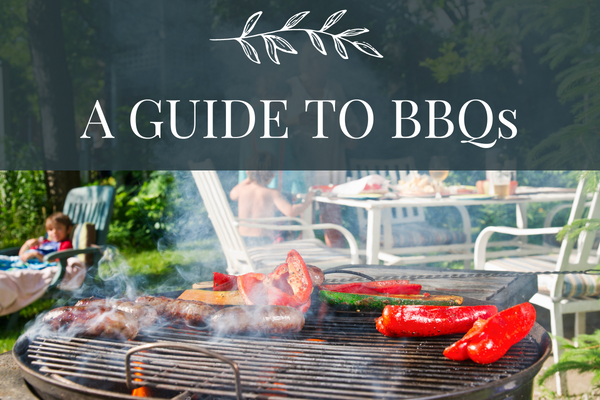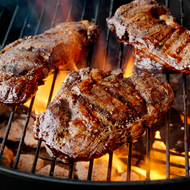Buying a BBQ: A guide
Posted by Original / Amy on 4th Jul 2022

During the summer months make the most of your garden and embrace outdoor living with a barbecue.
This guide is designed to help you pick the right barbecue to suit your space and needs.
Choosing between Gas and Charcoal BBQs:
Gas BBQ
Thanks to adjustable burner controls, gas barbecues provide variable heat when cooking. This make it a lot easier to cook food safely and evenly without burning it.
You are able to start cooking almost straight away. The simple, push-button ignition provides an instant flame, so your guests won’t be waiting for their food!
Tidying up is much faster, there is no need to wait for embers to extinguish and no charcoal ash to dispose of. Simply turn off the gas and wait for everything to cool before cleaning.
Some models come with multiple burners, so you can cook at different heat simultaneously. This is great if you want to cook different foods.
There are other cooking options including side burners (for sauces or vegetables), warming racks (great for garlic bread and keeping food warm) and griddles (lets you cook food that would normally fall through a traditional grill).
Although less portable, gas barbecues are usually larger. This allows them to cater for bigger numbers.
The Gas
The gas used for barbecues is normally propane, sometimes referred to as patio gas. Gas is more expensive to buy and on average a 13kg bottle will last for 15 cooking hours.
When you first buy gas, it’s normal to pay a deposit or hire charge for the cylinder in addition to the price of the gas. Once you have used your gas up, the supplier will exchange your empty cylinder for a full one. This time you only have to pay for the gas.
Charcoal BBQ
Provides a classic barbecue experience.
Food has a lovely classic barbecued appearance and a unique flavour created by the glowing embers.
Plan ahead – on average a charcoal barbecue will take around 20-30 minutes to reach the right cooking temperature.
Once the barbecue is ready, the heat is harder to control as the burning fuel can’t be adjusted. You are only able to control the amount of heat your food is exposed to by simply raising and lowering the grill.
Charcoal barbecues are relatively easy to light and burn cleanly. If you have trouble lighting your barbecue, you can use lighter blocks or gel to help with getting it started. The charcoal burns white when ready to cook.
Ash is produced from the burning charcoal and this must be removed after every use. There are some models which feature a one-touch cleaning system and removable ash-catcher which makes cleaning up much easier.
A great option for camping or if you are moving the barbecue around the garden.
Other Variations - Chimeneas & Fire Pits
Both of these are a fantastic source of heat and really complement garden furniture sets, creating the perfect outdoor seating area. Fire pits are often open whereas chimeneas are enclosed around the fire, funnelling the smoke out of a single chimney. Some models even come complete with grills so that you can cook up some food whilst warming up outside.
Barbecue Size Guide
Every barbecue has a cooking area which is measured in square centimetres. As a guide:
Up to 4 people – you need a smaller cooking area, up to 1800 square centimetres.
Up to 6 people – a larger area between 2000 to 2500 square centimetres.
Up to 8 people – the largest gas barbecues, over 2500 square centimetres would be ideal.
Key Features
BBQ Grill Types
Chrome plated Grills – used in more affordable barbecues. They look smart but be sure to clean thoroughly after use.
Stainless Steel Grills – Generally found on mid-range barbecues. It’s easy to clean and maintain, and more durable than chrome plated grills.
Cast Iron Grills – Hold heat very well, but requires more care. Wipe with oil before and after use to help prevent rust.
Porcelain-coated Grills – Transfer heat better and will last for years to come. They are easy to clean and the coating stops rusting. Some models feature flavouriser bars which help to create that smokey taste.
Griddles
A solid metal plate which provides an area to fry, braise or sauté food that would normally fall through the grill. Some models have this as well as a grill.
Hoods/Lids
If using a charcoal barbecue, lids can act as windbreaks. When the lid is closed, this creates a similar cooking space to an oven. The heat is more evenly distributed and cooks the meat more evenly.
Side Burners
Useful for cooking extras and keeping food warm, gas barbecues sometimes come with additional side burners.
Ash Collectors & Fat Drip Trays
Ash and fat are generated by cooking, Having an ash collector and fat drip tray make it much easier to get rid of these without having to clear the base of the barbecue.
BBQ Accessories
- Storage - To keep your barbecue working at its best, you need to think about how you will store it when it’s not in use. If you are not able to keep your barbecue in a shed or garage, then consider purchasing a cover to protect it from weather damage.
- Barbecue Tool Set - featuring tongues, forks and spatulas to safely remove food from a hot grill and a basting brush to add flavours and sauce.
- Grill Basket – to stop smaller pieces of food such as vegetables from falling through the grill.
- Food Tent – Protects food from insects and dirt.
Assembling and Positioning
- Assemble your barbecue as close as possible to where you’ll use it.
- Choose a level surface and keep away from plants and fencing.
- Try to find a sheltered position.






